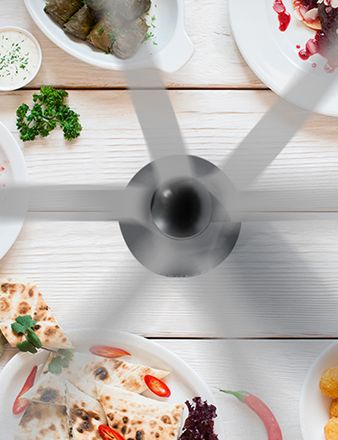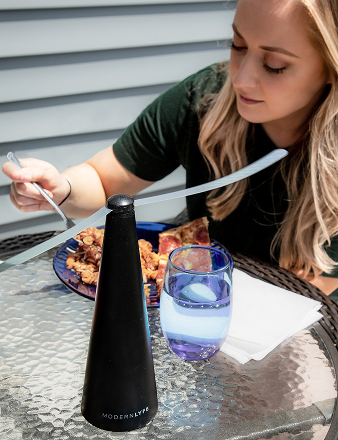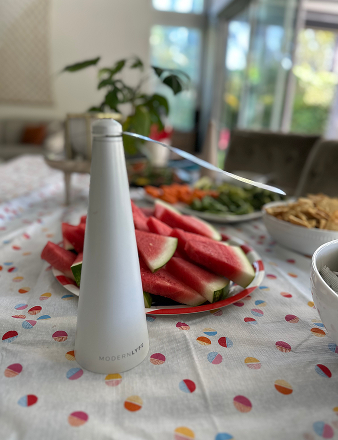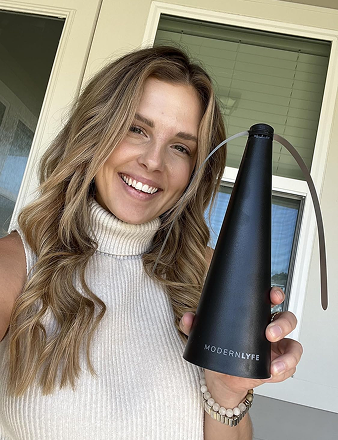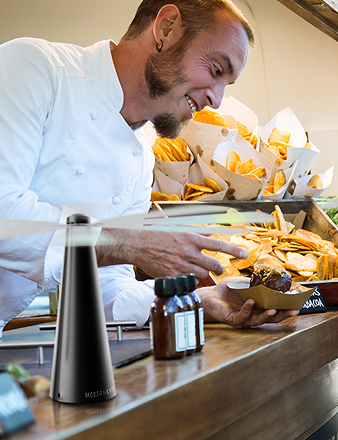You’ve set the table for a perfect backyard barbecue. The food is grilled, the drinks are cold, and the guests are arriving. Then, the first uninvited guest shows up: a fly. Soon, it's a full-on aerial assault, and you’re spending more time swatting than socializing.
This is a common frustration, and it’s exactly what the modern fly fan was designed to stop.
What Is a Fly Fan?

A fly fan is a silent, chemical-free bodyguard for your food. It's a small, battery-powered device with soft, rotating blades. Place it on your table, turn it on, and it keeps your space pest-free.
So, how does this simple gadget work? It uses a clever two-part strategy. First, the spinning blades create a gentle but consistent air current. While you'll barely feel it, this breeze makes it difficult for a lightweight fly to land.
The real genius, though, is in the blades. Most modern fly fans, like the MODERN LYFE Fly Fan, have reflective or holographic patterns. To a fly’s sensitive compound eyes, the constant motion and flashing light are disorienting. They perceive the area as a chaotic danger zone and instinctively stay away—no zapping, no swatting, no harm.
A Smarter Alternative to Old-School Methods
For years, our options for dealing with flies were less than ideal. Sticky flypaper is an eyesore, chemical sprays are unsafe around food, and bug zappers are loud and startling. A fly fan is a simple and effective departure from all of that.
Here’s why it’s a better choice:
- 100% Chemical-Free: It uses only air and light, making it completely safe around food, children, and pets. No toxic residues on your meal.
- Whisper-Quiet: The motor is designed to be nearly silent, so it won’t interrupt conversations or background music.
- Portable and Convenient: Most models are battery-operated, so you can take them anywhere—from campsites to restaurant patios.
Fly Fan vs. Traditional Pest Control
Here’s a quick comparison of how fly fans stack up against older methods.
| Method | Effectiveness | Safety (Pets/Kids) | Use Case | Chemicals |
|---|---|---|---|---|
| Fly Fan | High (in a defined area) | Excellent | Dining tables, food prep | None |
| Chemical Sprays | High (short-term) | Poor | Room clearing (unoccupied) | Yes |
| Fly Traps (Sticky) | Moderate | Poor (can get stuck) | General areas, away from people | No |
| Bug Zappers | Moderate | Poor (burn risk) | Patios, outdoor perimeter | No |
When it comes to keeping flies off your food safely, the fly fan is in a class of its own. It’s a targeted solution that solves the problem without creating new ones.
How a Fly Fan Actually Works
At first glance, a fly fan seems almost too simple: a base, a motor, and two soft, spinning blades. How can that keep flies off your food? Its effectiveness isn't about power; it's about smart insect biology.
The fan creates a two-part defense system that exploits a fly’s instincts. The first part is air movement. To us, the breeze is barely noticeable. To a tiny fly, it’s like trying to land a helicopter in a crosswind. This alone makes your food a less appealing target, encouraging the fly to find a calmer spot.
That's just the first layer. The real trick is how it messes with their vision.
Disrupting a Fly's Vision
To understand why this works, you have to know how a fly sees. They have massive compound eyes—thousands of tiny lenses working together. This gives them an incredibly wide field of view and makes them hyper-sensitive to changes in light and motion.
This is exactly what the fan’s blades are designed to exploit.
- Reflective Patterns: The blades feature shiny, holographic strips. These aren't just decorative; they catch and bend light as they spin.
- Constant Motion: The slow rotation turns these reflective patterns into a flickering light show.
Think of it like a disco ball throwing off confusing, chaotic beams of light. For a fly, whose brain is hardwired to interpret moving light as a threat, this is completely overwhelming. It doesn't see a fan; it sees an unpredictable danger zone.
Their self-preservation instinct kicks in, telling them to stay away. It’s a powerful deterrent that convinces flies to avoid the area without any physical contact. It's a behavioral trick, not a physical weapon.
This focus on sensory disruption is why the fly fan is such a safe and effective solution. There are no chemicals to spray on your food, no startling zaps, and no sticky traps to deal with later. It’s just a quiet guardian using science to make your meal a no-fly zone—perfect for use around food, kids, and pets.
The Real-World Benefits of Using a Fly Fan

A fly fan’s main job is to repel flies, but its true value is much deeper. This simple device improves the entire dining experience, whether you're at home or running a business.
The biggest benefit? It’s completely chemical-free. We’ve all become more conscious about the chemicals we use, especially near food. A fly fan eliminates that concern, giving you total peace of mind.
Unobtrusive and Portable Performance
Another key advantage is how it blends into the background. Let’s face it, the alternatives are disruptive. Bug zappers have that loud CRACK!, and citronella candles can overpower the aroma of your food. A fly fan is whisper-quiet and has no scent.
It does its job silently, letting you and your guests enjoy your meal and conversation without distractions. This alone makes it a superior choice for creating a comfortable, relaxed atmosphere.
The appeal of a modern fly fan is that it solves a problem without creating a new one. It provides effective pest control without the noise, smells, or safety concerns of traditional methods.
Then there's portability. Most fly fans are lightweight and run on batteries, so you can create a fly-free zone anywhere.
- Backyard BBQ: A couple of fans on the picnic table protect the burgers and salads.
- Indoor Kitchen: Place one on the counter to guard your fruit bowl or meal prep.
- Professional Catering: Set up a line of fans along a buffet to ensure perfect food hygiene.
Promoting a Clean, Hygienic Space
Ultimately, it comes down to hygiene. Flies are known for carrying bacteria and can contaminate any surface they touch. A fly fan acts as a gentle but firm bouncer for your food.
By preventing flies from landing on your meal, it directly improves food safety and reduces the risk of foodborne illness. This is non-negotiable for anyone serving food, from family cookouts to restaurants. For more great ideas, see our guide on how to keep flies away from food.
How to Choose the Right Fly Fan
Choosing the right fly fan is straightforward, but a few key details make all the difference. Considering your needs—whether for a quiet family dinner or a busy outdoor event—will help you find the perfect model. Let's cover what matters.
Power Source: Batteries vs. Rechargeable
First, decide on the power source. This choice is about convenience versus sustainability.
- Battery-Powered: These fans typically use AA batteries and can last up to 30 hours on a fresh set. They’re great for off-grid situations like camping or picnics.
- USB Rechargeable: This is the eco-friendly, cost-effective option. Charge them from a power bank, laptop, or wall adapter. Their runtime is usually shorter—around 10 to 15 hours per charge—but you'll never have to buy batteries.
Safety First: Blade Design
Next, focus on the blades. You absolutely want a fly fan with soft, flexible blades.
The gold standard is soft-stop safety technology. This feature is a game-changer. It instantly stops the blades the moment they touch anything—a hand, an arm, or a pet’s nose. This makes them completely safe to use around children and pets.
Coverage: Match the Fan to Your Space
Where you plan to use the fan is the biggest factor. A single fan might be perfect for a small café table but won't be enough for a long buffet.
For a small space like a four-person table or a kitchen island, one fan in the center is usually sufficient. It creates a protective bubble with a radius of about 2-3 feet.
For larger areas like a restaurant patio or a wedding buffet, you'll need multiple fans. A good rule of thumb is to place one fan every 4-5 feet. This creates a continuous barrier that keeps the entire zone fly-free.
This visual guide can help you decide what’s most important for your needs.
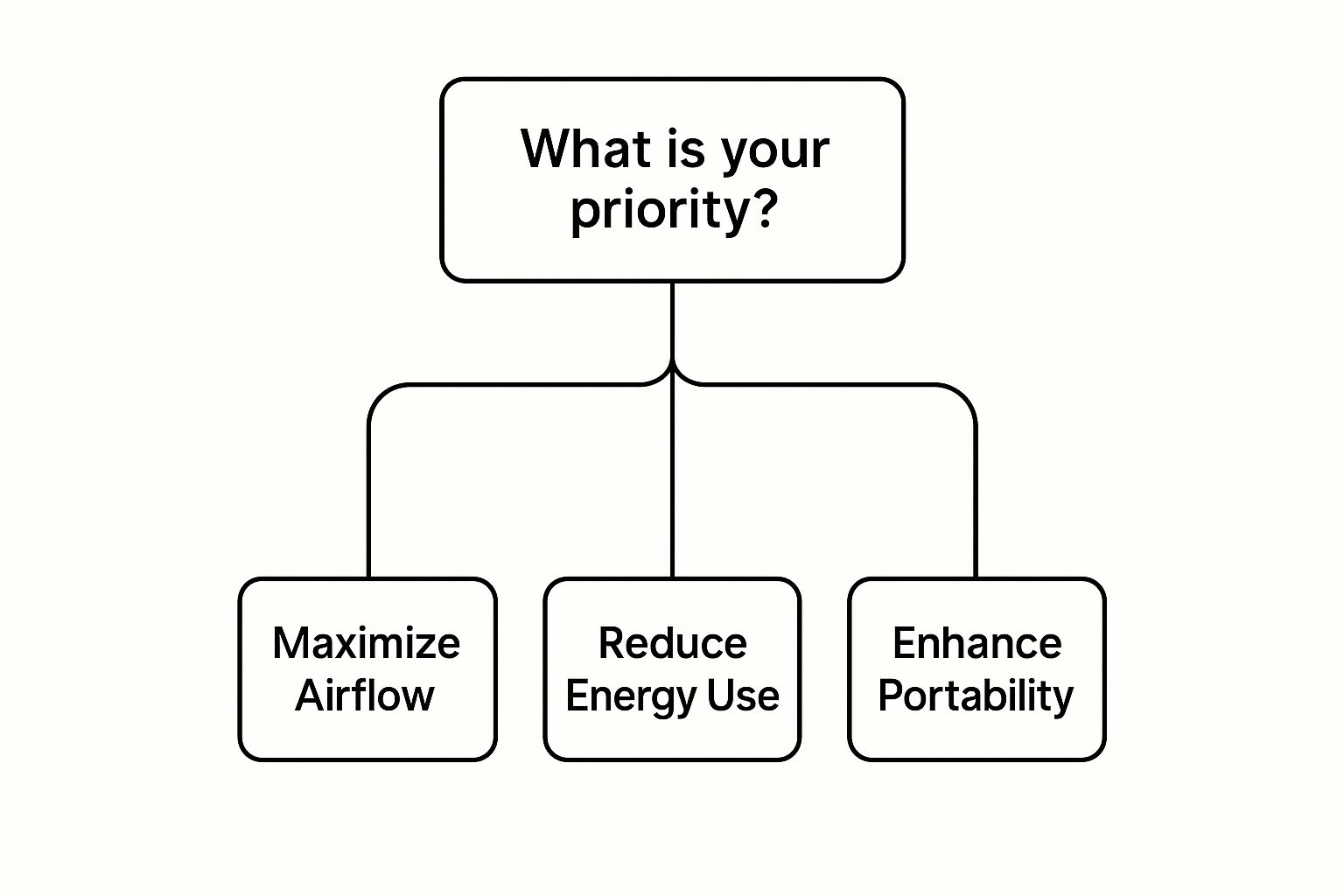
Choosing the right fan is often a balance between portability, power, and coverage area.
Fly Fan Feature Decision Guide
This quick comparison helps you decide which features are essential for your home, event, or business.
| Feature | Best For Home Use | Best For Outdoor Events | Best For Restaurants |
|---|---|---|---|
| USB Rechargeable | High Priority | Medium Priority | High Priority |
| Long-Life Batteries | Medium Priority | High Priority | Medium Priority |
| Soft-Stop Blades | Essential | Essential | Essential |
| Compact Size | High Priority | Low Priority | Medium Priority |
| Wide Coverage Area | Low Priority | High Priority | High Priority |
| Stylish Design | High Priority | Medium Priority | High Priority |
The best choice depends on your priorities. A homeowner might want a sleek design and quiet operation, while an event planner will focus on maximum coverage and long battery life.
Your Final Checklist
Before you buy, run through this quick checklist to ensure you find a model that fits your lifestyle or business.
Your Fly Fan Buying Checklist:
- Power: Will I be near an outlet, or do I need the freedom of batteries?
- Safety: Are soft-stop blades a must for my family and pets? (The answer is yes.)
- Coverage: How big is my space? Is one fan enough, or do I need a set?
- Style: Will this fan look good on my table?
It's no surprise that these devices are gaining popularity. The electric fan market, which includes specialty gadgets like these, was valued at USD 42.7 million and is growing. This reflects a larger trend: people want simple, effective solutions.
If you're ready to compare models, check out our guide to the best fly repellent fan to find the perfect match.
Where Your Fly Fan Will Shine

To understand why a fly fan is so effective, you have to see it in action. This device is a problem-solver, turning an annoying, swat-filled ordeal into a pleasant experience. Let's look at the specific places where this quiet guardian makes a difference.
Imagine a restaurant patio on a summer evening. The atmosphere is perfect, but a swarm of flies threatens to ruin it. By placing a sleek fly fan on each table, you create an invisible, pest-free zone. Guests can relax and enjoy their meal without swatting at bugs. It’s a small detail that improves customer satisfaction and makes your establishment feel more professional.
At Home and On the Go
The same magic works for your own get-togethers. Think of a classic backyard barbecue—the grill is hot, the food is out, and so are the flies. A couple of these fans on the picnic table will keep your dishes safe and the vibe relaxed.
Their utility doesn't end at your back door. The fly fan is a game-changer for many other situations:
- Family Picnics: Tuck one into your basket to keep your sandwiches and fruit fly-free.
- Kitchen Prep: Place one on the counter to guard ingredients as you cook, keeping your meal hygienic from start to finish.
- Camping Trips: A battery-powered fan is a must-have for keeping your campsite dining area clean and comfortable.
The core idea is simple: wherever you have food and people, a fly fan offers a silent, effective way to keep things pleasant. It protects both the food and the moment.
A Smart Investment for Any Business
For any business in the food industry, a fly fan isn't just a nicety—it's a smart investment in hygiene and customer experience. Food trucks can place them on the service counter to protect orders, reinforcing a clean, professional image.
Caterers can line them up along a buffet table at a wedding or corporate event, ensuring the spread looks pristine for every guest. This attention to detail elevates the entire experience. In a crowded market, these small things make a big impression.
The global market for industrial fans, which includes commercial-grade devices, was valued at USD 7.24 billion and continues to grow. You can find more on these trends at Grandview Research. This growth shows how much people are prioritizing effective air control solutions everywhere.
Answering Your Fly Fan Questions
Fly fans are simple, but you might have a few questions. Getting clear answers helps you use them effectively. Here are the answers to the most common questions we hear.
We’ll cover everything from safety and coverage area to battery life. The goal is to give you all the information you need to make your space a permanent no-fly zone.
Are Fly Fans Safe for Kids and Pets?
Yes, absolutely. This is the top concern for families, and it’s a priority for any quality fly fan. Most models are designed for homes and feature soft, flexible blades.
The key is “soft-stop” technology. It's a simple but brilliant safety feature. If a hand or a pet’s nose touches a spinning blade, the motor instantly stops. There’s no sting and no injury. This built-in feature makes them one of the safest pest control options available.
What Is the Effective Range of One Fan?
A single fly fan creates a protective bubble with a radius of about 2 to 3 feet. This is perfect for a standard four-person table or a kitchen island. Just place one in the center.
If you’re setting up for a larger crowd, you'll need more coverage.
- For a 6-person rectangular table: Two fans spaced evenly will do the job.
- For a long buffet line: Place a fan every 4 to 5 feet to create an overlapping barrier.
This strategy ensures there are no gaps for flies to sneak through, keeping your entire spread protected.
How Long Does the Battery Typically Last?
This varies by model, which is something to consider when planning for an event.
On average, a fan running on two standard AA batteries can last up to 30 hours of continuous use. A rechargeable USB model typically provides 10 to 15 hours on a single charge. Rechargeable models are a fantastic, eco-friendly option for daily use at home or in a restaurant.
Either way, you have more than enough power to turn them on and forget about them for the entire meal.
Do They Work on Other Pests Like Mosquitoes or Bees?
The fly fan is a specialist. Its design—the spinning motion and reflective blades—is specifically engineered to disorient the compound eyes of flies.
Will it work on anything else? The gentle breeze might annoy a few mosquitoes, but the visual deterrent doesn't affect them. Bees and wasps have different vision and flight patterns, so the fan has little to no effect. Think of a fly fan as your go-to expert for flies, and use it as part of a larger strategy for other pests.
Ready to create a pleasant, pest-free dining experience? MODERN LYFE offers elegant and effective fly fan solutions.

